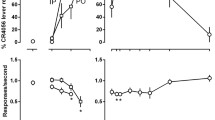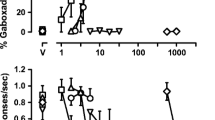Abstract
Previous studies have shown that discriminative stimulus control established with the 5HT1A receptor agonist, 8-OH-DPAT, generalises to other 5HT1A agonists and partial agonists but also to the α2-adrenoceptor antagonist, yohimbine. On the basis of these results it has been proposed that the 8-OH-DPAT cue may be produced by activity at more than one receptor. In the present study rats were trained to discriminate a dose of 8-OH-DPAT (0.05 mg/kg, SC) from saline. Substitution tests showed dose-dependent generalisation with the 5HT1A compounds, buspirone, ipsapirone, MDL 72832 and MDL 73005EF, the α2-adrenoceptor antagonists, yohimbine and idazoxan, and BMY 14802, which is usually described as a sigma ligand. The buspirone metabolite 1-pyrimidinyl piperazine (1-PP) which possesses mainly α2-adrenoceptor antagonist properties produced only partial generalisation which was not dose related. Receptor binding studies showed that all the compounds which substituted for 8-OH-DPAT displaced [3H]-8-OH-DPAT binding to rat hippocampal membranes. Furthermore, there were statistically significant positive correlations between drug affinity for 5HT1A sites and their ED50 values for both substitution for 8-OH-DPAT and potency to decrease response rates. These results are consistent with the view that the 8-OH-DPAT cue, like the ability of the compounds tested to decrease rates of responding, is largely mediated by activity at 5HT1A receptors.
Similar content being viewed by others
References
Arnt J (1989) Characterization of the discriminative stimulus properties induced by 5HT1 and 5HT2 agonists in rats. Pharmacol Toxicol 64:165–172
Barrett JE, Olmstead SN (1989) Spiroxatrine as a discriminative stimulus: effects depend on pharmacological history. Drug Dev Res 16:365–374
Bianchi G, Caccia S, Della Vedova F, Garattini S (1988) Theα 2-adrenoceptor antagonist activity of ipsapirone and gepirone is mediated by their common metabolite 1-(2-pyrimidinyl)-piperazine (PmP). Eur J Pharmacol 151:365–371
Bristow LJ, Baucutt L, Thorn L, Hutson PH, Noble A, Beer M, Middlemiss DN, Tricklebank MD (1991) Behavioural and biochemical evidence of the interaction of the putative antipsychotic agent, BMY 14802 with the 5HT1A receptor. Eur J Pharmacol 204:21–28
Colpaert FC (1984) Cross generalization with LSD and yohimbine in the rat. Eur J Pharmacol 102:541–544
Crist J, Surprenant A (1987) Evidence that 8-hydroxy-2-(n-dipropylamino)tetralin (8-OH-DPAT) is a selective α2-adrenoceptor antagonist on guinea-pig submucous neurones. Br J Pharmacol 92:341–347
Cunningham KA, Callahan PM, Appel JB (1987) Discriminative stimulus properties of 8-hydroxy-2-(di-n-propylamino)tetralin (8-OH-DPAT): implications for understanding the actions of novel anxiolytics. Eur J Pharmacol 138:29–36
De Lean A, Munson PJ, Rodbard D (1978) Simultaneous analysis of families of sigmoidal curves: application of bioassay, radio-ligand assay and physiological dose-response curves. Am J Physiol 235:E97-E102
De Vry J, Glaser T, Schuurman T, Schreiber R, Traber J (1991) 5HT1A receptors in anxiety. In: Briley M, File SE (eds) New concepts in anxiety. Macmillan, London, pp 94–129
Dickinson SL, Tulloch IF, Gadie B (1991) Effects of idazoxan on 5-hydroxytryptamine-mediated behaviour in the mouse and rat. J Psychopharmacol 5:187–195
Fuller RW, Snoddy HD (1987) Influence of route of administration on potency of the selective 5HT-1A agonist, 8-hydroxy-2-(di-n-propylamino)tetralin, in rats. Life Sci 58:409–412
Gartside SE, Cowen PJ, Hjorth S (1990) Effects of MDL 73005EF on central pre- and postsynaptic 5HT1A receptor function in the rat in vivo. Eur J Pharmacol 191:391–400
Giral P, Soubrie P, Puech AJ (1987) Pharmacological evidence for the involvement of 1-(2-pyridinyl)-piperazine (1-PmP) in the interaction of buspirone or gepirone with noradrenergic systems. Eur J Pharmacol 134:113–116
Glennon RA (1986) Discriminative stimulus properties of the 5HT1A agonist 8-hydroxy-2-(di-n-propylamino)tetralin (8-OH-DPAT). Pharmacol Biochem Behav 25:135–139
Glennon RA (1988) Site-selective serotonin agonists as discriminative stimuli. In: Colpaert FC, Balster RL (eds) Transduction mechanisms of drug stimuli. Springer, Berlin Heidelberg New York, pp 15–31
Glennon RA, Young R, Pierson ME (1989) Stimulus properties of arylpiperazine second generation anxiolytics. In: Bevan P, Cools AR, Archer T (eds) Behavioural Pharmacology of 5HT. Erlbaum, Hillsdale, New Jersey, pp 445–448
Hibert M, Moser P (1990) MDL 72832 and MDL 730053F: novel, potent and selective 5HT1A receptor ligands with different pharmacological properties. Drugs of the Future 15:159–170
Hoyer D (1991) The 5HT receptor family: ligands, distribution and receptor-effector coupling. In: Rodgers AJ, Cooper SJ (eds) 5HT1A agonists, 5HT3 antagonists and benzodiazepines. Their comparative behavioural pharmacology. Wiley, Chichester, pp 31–57
Kalkman HO (1990) Discriminative stimulus properties of 8-OH-DPAT in rats are not altered by pretreatment with parachlorophenylalanine. Psychopharmacology 101:39–42
Lucki I (1988) Rapid discrimination of the stimulus properties of 5-hydroxytryptamine agonists using conditioned taste aversion. J Pharmacol Exp Ther 247:1120–1127
Lucki I, Wieland S, Andrews R (1989) Differential modulation of the stimulus properties of 5-HT agonists by 5-HT neurons. Soc Neurosci Abstr 15:226
McCall RB, Harris LT, King KA (1991) Sympatholytic action of yohimbine mediated by 5HT1A receptors. Eur J Pharmacol 199:263–265
McCloskey TC, Paul BK, Commissaris RL (1987) Buspirone effects in an animal conflict procedure: comparison with diazepam and phenobarbital. Pharmacol Biochem Behav 27:171–175
Mir AK, Hibert M, Tricklebank MD, Middlemiss DN, Kidd EJ, Fozard JR (1988) MDL 72832: a potent and stereoselective ligand at central and peripheral 5-HT1A receptors. Eur J Pharmacol 149:107–120
Moser PC, Tricklebank MD, Middlemiss DN, Mir AK, Hibert MF, Fozard JR (1990) Characterization of MDL 73005EF as a 5HT1A selective ligand and its effects in animal models of anxiety: comparison with buspirone, 8-OH-DPAT and diazepam. Br J Pharmacol 99:343–349
Rodgers RJ, Shepherd JK (1989) 5HT1A agonist, 8-hydroxy-2-(DI-n-propylamino)tetralin (8-OH-DPAT), inhibits non-opioid analgesia in defeated mice: influence of route of administration. Psychopharmacology 97:163–165
Sanger DJ (1989) Discriminative stimulus effects of theα 2-adrenoceptor antagonist idazoxan. Psychopharmacology 99:117–121
Sanger DJ, Joly D, LePichon M (1989) Buspirone, gepirone and ipsapirone disrupt both active and passive avoidance responding in rats. Behav Pharmacol 1:153–160
Schoemaker H, Langer SZ (1986) [3H]8-OH-DPAT labels the serotonin transporter in the rat striatum. Eur J Pharmacol 124:371–373
Schreiber R, De Vry J (1989) Involvement of the dorsal raphe nucleus in the discriminative stimulus properties of the 5HT1A receptor agonist 8-OH-DPAT. Soc Neurosci Abstr 15:222
Taylor DP, Dekleva J (1987) Potential antipsychotic BMY 14802 selectively binds to sigma sites. Drug Dev Res 11:65–70
Tricklebank MD, Neill J, Kidd EJ, Fozard JR (1987) Mediation of the discriminative stimulus properties of 8-hydroxy-2-(di-n-propylamino)tetralin (8-OH-DPAT) by the putative 5-HT1A receptor. Eur J Pharmacol 133:47–56
Vander Maelen CP, Braselton JP (1990) Effects of a potential antipsychotic, BMY 14802, on firing of central serotonergic and noradrenergic neurons in rats. Eur J Pharmacol 179:357–366
Walker JM, Bowen WD, Walker FO, Matsumoto RR, De Costa B, Rice KC (1990) Sigma receptors: biology and function. Pharmacol Rev 42:355–402
Wettstein JG, Roman FJ, Rocher M-N, Junien JL (1991) Effects of sigma receptor ligands on schedule-controlled behavior of rats: relation to sigma and PCP receptor binding affinity. Psychopharmacology 104:157–163
Winter JC (1988) Generalization of the discriminative stimulus properties of 8-hydroxy-2-(di-n-propylamino)tetralin (8-OH-DPAT) and ipsapirone to yohimbine. Pharmacol Biochem Behav 29:193–195
Winter JC, Rabin RA (1989) Yohimbine and serotonergic agonists: stimulus properties and receptor binding. Drug Dev Res 16:327–333
Ybema CE, Slangen JL, Olivier B, Mos J (1990) Discriminative stimulus properties of flesinoxan. Pharmacol Biochem Behav 35:781–784
Zhang L, Barrett JE (1991) Modification of the discriminative stimulus effects of 8-OH-DPAT, buspirone and the β-adrenoceptor antagonist pindolol after chronic administration of the 5HT1A agonist 8-OH-DPAT in the pigeon. Behav Pharmacol 2:369–378
Author information
Authors and Affiliations
Rights and permissions
About this article
Cite this article
Sanger, D.J., Schoemaker, H. Discriminative stimulus properties of 8-OH-DPAT: relationship to affinity for 5HT1A receptors. Psychopharmacology 108, 85–92 (1992). https://doi.org/10.1007/BF02245290
Received:
Revised:
Issue Date:
DOI: https://doi.org/10.1007/BF02245290




